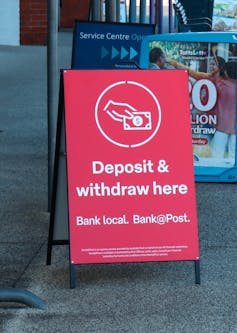Lee Smales, The University of Western Australia
On Tuesday, Commonwealth Bank announced it was planning to move customers using one of its legacy accounts to its newer “Smart Access” account.
The catch? That migrated customers would then be charged a $3 “assisted withdrawal fee” whenever they took money out at a bank branch, post office or over the phone.
The move sparked uproar, with politicians on both sides immediately calling for a rethink of the decision.
On Wednesday, they got one, sort of. Commonwealth Bank announced it would pause the account changes for six months for the “10%” of affected individuals it said would be worse off under the change.
The spat has drawn attention to the fight over what’s fair in the effort to keep cash and bank branches alive for the Australians who still rely on them.
Clearly, letting the banks charge their own extra fees is a political non-starter. But the government has some other ideas, including a cash mandate for essentials and a possible new rural services levy to keep branches open.
Why is it so important to keep bank branches open and cash access alive, particularly in the regions? How might a levy work, and what are the alternatives?
Losing access hurts the regions
Since 2017, more than 2,000 bank branches have closed across Australia. Many of the losses have been in rural areas.
Demographic changes and population decline in rural areas, a shift to digital banking and a continued fall in cash use all mean there is simply far less foot traffic.
Branches themselves are costly to maintain. In addition to rent, wages and security costs, it is expensive to move cash around the country – often prohibitively so for the more remote reaches of Australia.
Rural bank branch closures can have significant social and economic impacts on rural communities, disadvantaging them in comparison to those in urban areas.
Of particular concern are vulnerable groups who may lack reliable transportation options or adequate internet access.
Losing a local banking presence can also have serious impacts on small businesses. Credit access is constrained if credit assessors based in urban areas fail to understand the needs of rural businesses.
Some businesses are highly dependent on cash and need access to branches to manage their cash “float” (used for providing change and covering minor expenses).
Reliable access to cash is also particularly important for businesses based in remote regions who may have unstable network access (needed to operate EFTPOS machines), or in sectors such as tourism.
A rural services levy
Last month, it was revealed that Treasury was considering a new levy on Australia’s banks to help fund regional banking.
Under the proposal, the levy paid by each bank would depend on the number of regional branches and ATMs it maintained, relative to its household deposits.
Preliminary estimates reported in the Australian Financial Review suggest the banks with large regional networks would be the biggest beneficiaries of such a scheme, as you’d expect.
This includes Bendigo and Adelaide Bank, estimated to receive about $200 million a year under the proposal. NAB and Rabobank could also be net beneficiaries due to their large agribusiness presence.
Banks with an online-only presence, such as ING and Macquarie, would predictably be among the biggest losers, a group which also includes Commonwealth and Westpac.
It’s estimated these banks could pay individual levies north of $60 million a year. For Westpac, it could be more than $100 million.

Could there be unintended consequences?
Some have expressed concerns that imposing such a penalty on online-only banks would further stifle competition in what is already a noncompetitive sector.
Between them, Australia’s big four banks currently control more than 75% of the mortgage and deposit market.
There’s also a broader risk that bank levies get passed on to customers in the form of higher mortgage rates or lower interest rates on deposits.
Research examining a levy imposed on German banks in 2011 found that on average, regional banks raised their lending rates by around 0.14% in response. That’s equivalent to more than half of the typical 0.25% move in the RBA cash rate.
Lessons from around the world
Australia isn’t the only country struggling with the challenges of regional banking.
Direct levies are rare. However, a variety of other policies focused on regulatory mandates have aimed to provide and maintain access to banking in regional areas.
India has experimented with mandates to maintain branch networks in smaller towns and rural areas.
In the US, the Community Reinvestment Act requires banks to meet the needs of regional communities, otherwise they face limits on expansion.
In Canada and the UK, banks are required to consult with communities before closing branches and must provide alternatives, such as mobile banking.
In South Africa, there is a combination of mandated services in remote areas and incentives that see banks earning points under a formal economic inclusion and empowerment framework.
Leaning on the post office
Across several countries, the post office has played a crucial role in providing basic banking services, similar to the Bank@Post program run by Australia Post.

In consultation with communities, expanding the Bank@Post program could be one of the most viable ways to support regional banking into the future.
Expanding banking services could further offer a “win-win” for Australia Post. Its own branches are also dealing with lower foot-traffic as fewer letters are sent.
The UK’s banking hub system, in which major banks are members of a not-for-profit company and operate through the Post Office, offers one possible framework for such an expansion.
Lee Smales, Associate Professor, Finance, The University of Western Australia
This article is republished from The Conversation under a Creative Commons license. Read the original article.


Banks In Australia were in most cases run by Governments, however after privatisation it seems that the service aspect disappeared in an attempt to maximise profits.
I should declare that I have shares in two banks, not many, and do my banking with another.
Over recent years firstly the trend was to provide ATM’S everywhere, then came the rationalisation of Branches.
They then started closing Branches and having in shopping Centres, then the same thing happened with ATM”s, so they could only be accessed during the Shopping Centre trading, after you found a parking spot, so rather than a few minutes it could take up to twenty minutes to use an ATM.
They also started withdrawing from smaller and medium sized towns, firstly leaving ATM’S, before removing them also.
These are great for the bottom line and forcing people to bank online.
However with online banking, you must have access to the internet, many low income people cannot afford it,and many regional areas do not have coverage.
just pure greed! they don’t want to lose the massive credit card charges.
Then they suggest everyone can do there banking at Post Offices, the same Post Offices which are now closing in large numbers, and also retreating to inside shopping centres.
What they have not consider is the many people and businesses that need to access banking services .
I know of a town that 5 years ago had 4 banks and a Post Office, now it has none. Businesses need to close their business for an entire day to travel to a regional centre to bank cash and obtain float cash.
Even the areas where there are Post Offices providing banking services as an agent, the Post Office have neither the banking service skills or security.
Many people, my wife among them, have vision problems, and even though she uses tap and go, when she has to to enter a pin number she cannot see the keypad.
With internet banking being forced on customers, the banks are putting their saving and investments at risk of scammers.
Maybe as part of renewal of Bank licences they be required to fulfil a number of conditions.
Some of these should be:
1. Assume total responsibility for any funds accessed by a third party because of electronic banking.
2. Provide access to ATM’s 24/7 in all towns with over 500 people.
3. Provide adequate security systems for banking services in Post Offices In towns with over 500 people.
4. Provide a full banking services of a least one bank, in every town with population in excess of 1000 people.
It can be decided by the Banking Industry Counci as to which bank will provide the service in each particular town. If the Banking Industry Council cannot provide a service within six months then the Banking Ombudsman with make directive as to whom shall provide the service within 6 months.
5.That any new account must provide the option not to use online banking.
‘Then they suggest everyone can do there banking at Post Offices, the same Post Offices which are now closing in large numbers, and also retreating to inside shopping centres.’
Spot on! Really makes one think if they see things as they are on the ground…
The cost of using cash used to be priced into the banks’ operating model and the cost spread across all customers, when all customers used cash. Now most customers don’t use cash, and those who do are the banks’ least profitable customers. So the bank is able to recover the costs of servicing the 87% of customers who don’t use cash with the fees that are automatically charged for card transactions. And lots of those customers are also paying their credit cards off late and contributing handsomely to bank profits.
Banks are very reluctant to keep providing loss making services. Usually we expect governments via the taxpayer to be providing essential but unprofitable services, not commercial enterprises.
This will become more of a problem where the government has abandoned providing unprofitable essential services and privatised them. Think housing, water supply, telecommunications, aged care, child care and many more. The privatised entity doesn’t want to risk its profitability by having to service unprofitable customers.
A big question? Can commercial enterprises be forced to service unprofitable customers, where those enterprises are providing essential services? Should they be forces to do so?
I use cash just about every day, and at least $200 per week. With the reduction in Bank provided ATM’s (which are fee free) the only ATN’s available are provided by Private Companies, which charge, effectively, large fees. I have been forced to use some of these that charge between $3 & $4 per transaction. and have started to use one that was going to charge a fee of $5.20, and I cancelled that transaction, and deferred until I found another ATM.
I do also use Electronic Transfer, and Credit Cards, but there are some transactions where you cannot use these.